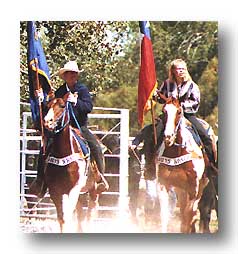General -
Cal Farley's Boys Ranch is a
nationally known home for boys and girls who benefit from
guidance,  affectionate
discipline, and education in a ranch setting. Established
in 1939 by the late Cal Farley, Texas businessman and
world welterweight wrestling champion of the late 1920's. affectionate
discipline, and education in a ranch setting. Established
in 1939 by the late Cal Farley, Texas businessman and
world welterweight wrestling champion of the late 1920's.
The first boys who came to the
ranch lived in the abandoned courthouse of Old Tascosa
that is now the Julian Bivins Museum (see below). Founded
and expanded by private donations, the ranch today covers
10,600 acres. Facilities include a chapel, clinic,
schools, fine arts and auditorium, visitors center, and
23 homes for children.
More than 400 boys and girls help
operate the ranch, attend school and vocational classes,
and enjoy a year-round program of athletics.
A popular annual event is the Boys
Ranch Rodeo, Labor Day weekend, featuring
competition among youths of all ages.Although some 80
percent of the young people were heading for trouble
before coming to the ranch, most remain and graduate from
the fully accredited Boys Ranch High School, entering the
adult world as useful, self-reliant citizens. Visitors
are welcome at the ranch. Open daily 8a.m-5p.m.
Boot Hill Cemetery-
When Tascosa (below) was the wide
open , riotous cowboy capital of the 1880's, gunfights
were the traditional means for settling disputes, and
it's cemetery was an essential part of the town. The boys
maintain the cemetery today. U. S. 385.
Julian Bivins museum-
Housed in the former Oldham County
Courthouse, name honors Panhandle rancher whose donation
of land formed the nucleus of Boys Ranch. Artifacts from
Indian and prehistoric Panhandle cultures, cowboy and
pioneer items, photos and docunents about Boys Ranch
history. Open daily year round, 10a.m.-5p.m.
Old Tascosa-
Pioneer settlers in the early
1870's built adobe huts and irrigation ditches along area
creeks. After 1875, village became a supply and shipping
point for several huge Texas ranches, including the famed
XIT and LIT. Bustling town was known as "the Cowboy
Capital of the Plains"; became county seat when
Oldham County was organized in 1880. The famous and
infamous-from Kit carson to Billy the Kid-once strode
it's rough plank sidewalks. But as with many Texas cow
towns, decline set in when the open range was girded with
fences, and the railroad bypassed the site. it was
deserted by the 1930's. |


